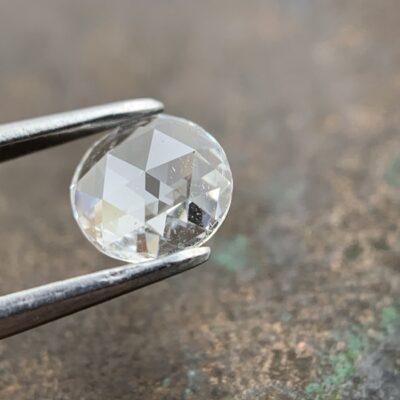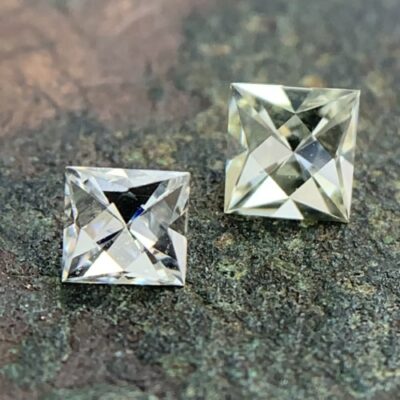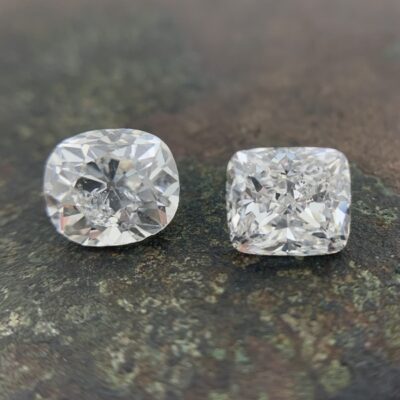What are Antique Cut Diamonds?
Imagine a time not too long ago where like many other fields, the field of diamond cutting and polishing required masterful artistry using your hands. Before electricity was discovered harnessed, heck, some of the cuts were created before steam powered tools!
While the skills required to create diamonds today are impressive in their own right, we’re talking about a time where diamond machinery was not in the picture whatsoever (they were introduced in the 20th century). This includes eras like the Georgian and Victorian Era, the Art Deco and Edwardian era, which all played their own role in the evolution of diamonds to the point we are at today of modern cuts made to achieve maximum brilliance.
And yet, despite the benefits modern cuts bring, such as maximum light play, brilliance, and symmetry, it’s undeniable that the antique and vintage are making a comeback, with their mystique and warmth. Chances are you’ve heard the term antique cut diamonds when skimming through engagement rings and other forms of jewelry. But what is an old mine cut diamond? And for that matter, what is an old European Cut or Rose Cut? In this article we’ll go over the main types of old cut diamonds, their characteristics, and their role in the evolution of modern diamonds.
But first, let’s understand the core differences between the majority of antiques and modern diamonds.
Antique Cuts vs Modern Cut Diamonds

There were many factors that dictated what was considered the ideal cut diamond in past eras. Some were due to lack of tools, while others, environmental.
Viewing conditions
While viewing conditions may sound strange and vague, it’s actually quite simple. Consider the conditions in which antique cut diamonds were viewed. They were either under gas or candlelight, which by all means today would be considered a low light setup. The focus in that case by the cutters and polishers is to create a sense of warmth and an emphasis on size, color and clarity which work great under candlelight, but are vastly inferior to modern cuts in terms of brilliance and fire, as well as symmetry.
Technology
As to be expected, the technological differences between the antique cut diamonds and modern ones are vast. They were cut and polished by hand by remarkable artisans, which gives a beautiful meaning and also uniqueness to each stone. On the other hand it also made them not very symmetrical, and the facets tend to be much chunkier. And yet, even throughout the evolution of the antique we saw technological growth, which is why each antique cut tends to have more sparkle than its predecessor.
Knowledge
A popular belief at the time of the old cut diamonds was also supported by its viewing conditions, but at the same time was vastly inaccurate. For example it was thought that having a large cutlet will add more sparkle, and nothing could be further from the truth. That’s just one example of how the natural progression of knowledge and experience, helped improve the brilliance of modern diamonds which have little to any culet.
What are Single Cut Diamonds?

The single cut diamond is one of the most historically significant stages in the evolution of diamonds, and was introduced near the end of reign for the previous king of diamonds, the table cut. They are said to have originated in India at the end of the 14th century, and yet only began to truly be implemented in Europe in the 16th century.
They are structured quite uniquely due to the rather primitive understanding and methods of the time, with 16 facets in total (8 facets in the crown, and 8 facets in the pavilion). Though technically there are 17 facets if you count the one added to the table.
However, single cuts aren’t just an antique and historical diamond, they were in fact a key player in the melee diamond industry until the 80’s and 90’s (loosely 0.0025 to 0.10 cts), However, the advancement in technology helped achieved a full cut melee diamond which has become the prevailing choice. And yet, the single cut still plays a role in micro pave pieces and even in watchmaking.
Single Cut VS Full Cut Diamond
The single cut vs full cut debate is much like the comparison between the old European cut and the brilliant round cut. Perhaps even more so because you’re comparing an even older stage of the diamond evolution which had 8/8 facets.
As soon as technological progress allowed even melee diamonds to have 57-58 facets, it was obvious the single cut would become less relevant. Visually, the brilliance of the full cut is vastly superior, and yet there’s the subtle antique warmth that many actually prefer, especially surrounding their antique piece.
What are Rose Cut Diamonds?

While there were other cuts that came in after the single cut, the most prominent one that is beloved by fans of antique and vintage jewelry is the rose cut. It dates back to the 1500s.
It got its name based on how its facets are set, bearing a beautiful resemblance to that of rose petals. It was at its peak during the Georgian era and fell off in popularity during the introduction of more modern cuts, until the rediscovery of its beauty which we’re experiencing today.
The Characteristics of a Rose Cut Diamond
As previously mentioned, the rose pattern created by the facet structure is one of the most recognizable aspects of the rose cut diamond, one that is incredibly elegant and charming. What makes the pattern is its triangle shaped facets which are quite random from one another, as some pieces can have 5 facets, while others 22 or 24, and they are easily spotted due to their flat base.
Rose Cut vs Brilliant Round Cut Diamond
One of the unique aspects that separate the rose cut from the modern round dramatically, other than the number of facets, is the fact that it doesn’t implement what is known as a peaked bottom. As one would suspect, this means its brilliance is miles behind the modern cutting techniques which include 57-58 facets and a peaked bottom. Visually it means that light is retained within the rose cut and creates a more lustre as opposed to fire and brilliance.
Not all diamonds that weigh the same, look the same, and this is especially true for the rose cut. Its weight distribution is such that the entirety of its weight is situated at the very top, which gives the appearance of a larger stone.
How the Rose Cut Compares to other Old Cuts
As the time in its creation is among the oldest, so does the brilliance, or lack thereof of the rose cut is compared to the old mine and old European. Why? because of the evolution of knowledge over time, primarily in terms of how the table is constructed. The flat base which is one of the more recognizable aspects of the rose cut is the difference maker compared to the more elaborate pavilion that was introduced later on. And yet, it remains popular to this day due to its highly unique rose petal pattern, warmth and elegance, which works incredibly well with antique and vintage jewelry.
One of the most appealing factors about the rose cut is that due to its rather flat base, they are quite flexible in working with various creative shapes, while maintaining their stunning antique beauty. Among its most popular variations you’ll find the classic round, pear shaped rose cuts, square cut rose cuts, hexagonal rose cuts, and more.

What are Old French Cut Diamonds?

The French Cut is a fan favorite when it comes to antique, especially art deco jewelry. Its name is somewhat vague and is said to have been given to it due to its high popularity in France. It is also recognized as the worthy ancestor of the beloved modern princess cut diamond.
While its origin is not as clearly defined as some other cuts, it is said to have originated in the 14th century, and is considered one of the next stages in the evolution of the historical table cut. However, it was somewhere in the 17th century where it gained its well deserved popularity, during the art deco era, an era known for its love and appreciation of geometric designs.
Unlike many other antique cuts, the french cut is immediately recognizable with its criss cross pattern, and rhombus shaped table. Its outline is square, sometimes leaning towards the rectangular. Later on, the french cut was used in other shapes, but for its true origin, that is how it is defined.
French Cut vs Princess Cut
As with many antique vs modern, the number of facets tells a vivid story right away. The french cut diamond has anywhere between 18 to 24 facets, less than half of what the modern princess showcases, ranging from 57 to 76 individual facets.
In terms of brilliance, the princess is miles ahead as to be expected. However, in terms of warmth and lustre, the french cut is an incredibly fascinating choice with a clear geometric beauty.

What is an Old Mine Cut Diamond?

It would be impossible to have a serious discussion about antique and vintage cut diamonds without mentioning the old mine cut, which are held in high regard to this day.
However, before delving into that, it’s important to make a much needed separation from the interchangeable way the term is used. For example, old european cuts, and even rose cuts are misrepresented as old mines, which despite sharing similarities is factually inaccurate.
The shape of the old mine is square with soft edges, reminiscent of the modern cushion cut, though it is considered one of the stages towards the intention of achieving the perfect round diamond.
The old mine was most prominent during the Georgian, Victorian, and Edwardian Eras, and dates back to the 1700’s, until the arrival of the old European cut which was introduced in the 19th century and we will discuss later.
Why the Name Old Mine?
Old Mines were originally mined in India and later in Brazil, which were the dominant mining areas in the 18th century, until the discovery of the mining opportunities of South Africa. The term old mine therefore, as the name would suggest, attributes that time of cutting and polishing by hand, the rough material provided by the old mines of India and Brazil.
Old Mine vs Cushion Cut Diamond
Characteristics
The old mine is square shaped in nature with soft rounded corners, and represents an interesting part of the evolution of diamonds towards creating a perfect round cut. However, it bears a striking resemblance to the cushion cut which is considered its direct descendant. Upon closer examination however, there are some substantial differences which are to be expected with more than a century between them. The cushion is depicted as being square with soft edges, but also square with slight rectangular characteristics.
The Culet
One of the most distinct aspects of old mine cuts has to do with the Culet, which is the facet situated at its utmost bottom section and also the quickest ways to spot an old mine cut. Whereas modern cuts have a small, or non existent culet, which translates as a perfectly positioned pointed tip, the old mine has a noticeably larger, open culet. This creates what is known as the window effect, at its very center, which is a big no no in today’s modern cuts including the cushion.
The Facets
The number of facets the old mine is known for are 58, compared to the 64 used for the modern cushion cut. That’s undoubtedly one of the many factors that contribute to the difference in sparkle but not the only one. The Old mine incorporates larger, uneven , chunkier facets due to the old methods used at the time. The larger culet also contributes to shorter facets at the bottom.
Crown, and Pavilion
Another distinct characteristic that the old mine cut has are its higher crown and deeper pavilion. For those that don’t know the crown is the upper section of the diamond, while the pavilion represents its lower section. When placed inside a ring, this difference is very noticeable and unique, as the crown sits very high compared to the modern cushion which also has a more shallow pavilion.
Size of the Table:
Another key difference between the old mine and the modern cushion shape are the size of the table coverage of the total diameter of the stone. In the case of the old mine, it only covers 38-45%, unlike the case for cushion cuts which is 66-70%.
Girdle
The girdle is another small, yet important factor in diamonds where there’s a noticeable difference between the old and the new. It is defined as the divider of the upper crown and the lower pavilion, and is often used as the base for measuring the length and width of diamonds.
While modern cuts have a rather subtle girdle, antique cuts, including the old mine have a noticeably thicker girdle.
Old European Cut Diamond

The Old European is the next stage in evolution following the old mine cut towards the goal of achieving a round cut diamond. It is often mistaken and called an old mine cut due to sharing many similarities to its old mine predecessor. However, even with the naked eye, one could notice the difference leaning towards a more rounded shape.
The old European cut started its influence and eventual take over for the number one position somewhere in the late 1800s as a more modern rendition of the old mine, with numerous advantages gained through knowledge and developing technological innovations, though both cuts were still created by the hands of skilled artisans.
Old Mine vs Old European Cut
While both share a similar number of facets, there was a true indication of the future that is to come when comparing the old mine and old European cut. It is after all, the intermediate evolutionary point between the modern brilliant round that we know today, and the old mine.
Shape
The old mine cut can be defined as a square shaped with rounded edges, reminiscent of today’s cushion cut diamond. Of course it came in a variety of shapes, but that is how it was traditionally. The Old European is a progression towards the perfect round cut although it wasn’t there just yet, it certainly has its own beauty and elegance.
Table
One of the most noticeable differences between the old mine and old European stems from their table. Whereas the old mine is famous for having a small table, the old european implements a larger table, and elongated facets.
Culet
The old mine is also known for having a larger culet, which had a tremendous effect leaning more towards warmth as opposed to brilliance, as it caused a window to appear. The smaller culet of the old European gave the world a sneak peek towards the future, with increased fire and life, yet maintaining the warmth of the antique style, which is why it is such a beloved diamond shape.
You see, while one of the key characteristics of the old mine was its lack of symmetry, the old European has more elongated facets, and a smaller table which leads to noticeable symmetrical improvements.
Peruzzi Cut Diamond

We often wonder why the Peruzzi cut diamond is rarely mentioned in posts going over the most important antique cots. The old mine, old European, and Rose Cut always get their well deserved praise, but the Peruzzi is a truly unique cut with massive impact and unique beauty.
In order to understand why, we look at the times of its creation.
The History of the Peruzzi Cut
There’s no argument as to who created the Peruzzi as it’s named after its creator. A superb polisher by the name Vincent Peruzzi from Venice, Italy. Vincent, using the Mazarin cut as a base for improvement, had a very specific goal, of evolving into a diamond that has superior sparkle compared to its predecessors. He achieved it (relative to the time) and made tremendous improvements from 17 to 33 facets, and etched his name in history. It was the inspiration towards the next evolutionary stage, the old mine cut.
Even at the time of its creation, despite the remarkable achievement, the market demanded rose cuts, and as a result, not many peruzzi cut diamonds were created. A genuine mistake we’re suffering through to this day, despite the beauty of the rose cut, the world could use more Peruzzi cuts.
This means that out of the majority of antique cut diamonds, an authentic Peruzzi is the most rare and expensive.
The Characteristics of a Peruzzi Cut Diamond
The Peruzzi is a rounded square shape resembling the cushion cut diamond, and often described as being a rough cushion shape. What makes the Peruzzi cut stand out in particular is its rectangular notch situated at the corners.
Since the majority of diamonds at the time of the Peruzzi cut’s creation had 8 facets, an alternative name it received is the triple cut, due to upgrade, having triple the amount at 33 facets, which showed their presence at the crown area, and are quite broad in structure.


